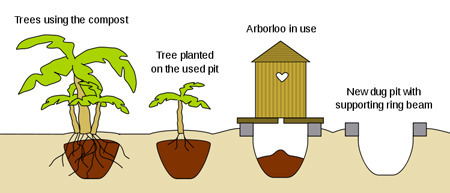Arborloo
Just how do latrines work? Essentially, like a compost heap. As long as the material discarded is limited to organic solid waste and a minimum of liquid waste (such as urine and gray water), organisms from the soil will invade the growing mass and break it down into usable nutrients. At the same time, the liquid will leech into the ground where it will also be processed by other microorganisms, thereby cleaning the water before it re-enters the aquifer or a body of water.
If the rate of influx of waste does not exceed the rate of decomposition, an individual latrine can be used indefinitely. However, if influx does exceed decomposition, the pit will eventually fill up. At that point it needs to be buried and a new latrine pit dug.
A good way to take advantage of the old buried pit is to plant a tree or shrub over it. This is called an "arborloo". The growing plant will use the nutrients released by the decomposing waste (and help speed up decomposition), growing faster and larger than plants in surrounding soil, especially if the soil is nutrient poor, and there is virtually no danger of contamination. If the plant produces food, or is a non-food plant that can be regularly harvested for needed material, it can return some of the waste biomass to the family or community that used the latrine, and any extra food or material can be sold to provide needed cash. Similarly, a cash crop can be grown over the buried pit for the same purpose.

If the rate of influx of waste does not exceed the rate of decomposition, an individual latrine can be used indefinitely. However, if influx does exceed decomposition, the pit will eventually fill up. At that point it needs to be buried and a new latrine pit dug.
A good way to take advantage of the old buried pit is to plant a tree or shrub over it. This is called an "arborloo". The growing plant will use the nutrients released by the decomposing waste (and help speed up decomposition), growing faster and larger than plants in surrounding soil, especially if the soil is nutrient poor, and there is virtually no danger of contamination. If the plant produces food, or is a non-food plant that can be regularly harvested for needed material, it can return some of the waste biomass to the family or community that used the latrine, and any extra food or material can be sold to provide needed cash. Similarly, a cash crop can be grown over the buried pit for the same purpose.

Published on December 21, 2013 21:44
•
Tags:
green-technology, sanitation, toilets, trees
No comments have been added yet.
Songs of the Seanchaí
Musings on my stories, the background of my stories, writing, and the world in general.
- Kevin L. O'Brien's profile
- 23 followers



